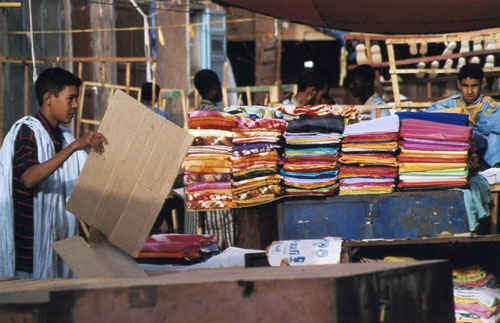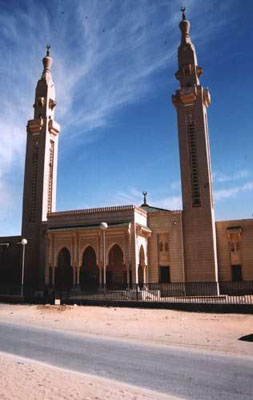Nouakchott began as a village in the desert on the caravan route north from Dakar, and was chosen in 1958 to be the site of the national capital. Before that, Mauritania shared a capital, Saint-Louis, in Senegal, with the other members of the French West African Federation.
Nouakchott is located on the Atlantic coast and provides access to the Sahara and Sahel regions alike, but it is rapidly getting entirely surrounded by the Sahara, with sand piling up against walls and fences.
Recurring draughts have forced people to leave their villages and head for the city, which has grown about 40-fold in the last 50 years. Its population is around 881,000
In addition to being the seat of government and administration, Nouakchott is a growing commercial centre and has a printing works, a hospital, and numerous schools. Its water supply is provided by a desalinization plant. The hospital, designed shortly after independence, is unique in that it has wards which are linked by inner courtyards.
It is home to the Nouakchott National Library (founded 1965) which houses a collection of manuscripts, the silver market, and unspoiled beaches. One beach is devoted to fishing boats where various species of freshly caught fish are sold. There are two mosques; one a gift of Saudi Arabia in the town center, the other, a gift of Morocco further south. Nouakchott has a National Museum, which offers a good introduction to the lifestyle and culture of the nomads of Mauritania. The city is home to the Université de Nouakchott, opened in 1981, the only university in Mauritania. The National School of Administration (1966), the National Institute of Advanced Islamic Studies (1961) and the National Archives are all here.
Movie theatres are found in the Mauritania’s main urban centers, and cercles (social, sporting clubs) provide recreational opportunities in Nouakchott, Nouadhibou, and Rosso.
An agreement was signed on August 5, 2007 between Mauritania, Sudan, and China to build $630m Mauritania Railway linking the port of Nouakchott and phosphate mines at Bofal, about 430km away. The line goes near the border with Senegal.
The deep-sea port, opened in 1986 at Nouakchott, can accommodate 320,000 tons of shipping a year. Processed copper had been exported along a highway to the wharf at Nouakchott. There are substantial gypsum deposits near Nouakchott; most of the annual production is exported to Senegal.
There are international airports at Nouakchott and Nouadhibou, and other cities are linked by regular air services.
References: Encyclopedia Britannica http://www.britannica.com/nations/Mauritania
Wikipedia, the free Encyclopedia http://en.wikipedia.org/wiki/Nouakchott



